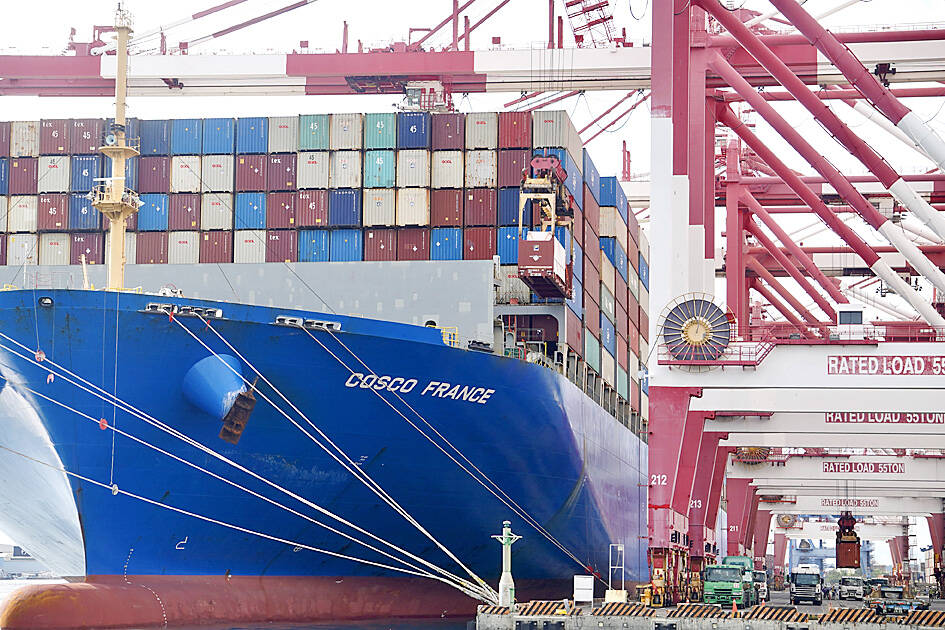The proportion of Taiwan’s exports directed to China, including Hong Kong, declined by more than 12 percentage points last year compared with its peak in 2020, the Ministry of Finance said on Thursday last week.
The decrease reflects the ongoing restructuring of global supply chains, driven by escalating trade tensions between Beijing and Washington.
Data compiled by the ministry showed China and Hong Kong accounted for 31.7 percent of Taiwan’s total outbound sales last year, a drop of 12.2 percentage points from a high of 43.9 percent in 2020.

Photo: CNA
In addition to increasing trade conflicts between China and the US, the ministry said the decline reflected a weakening Chinese economy caused by a fragile property home market and falling domestic demand.
The ministry said a fall in exports to China also came as the Chinese government intensified efforts to push for the “Made in China 2025” initiative to replace imported goods with those made domestically.
The reduction in exports last year was largely made up of petrochemical, base metal and machine tool suppliers due to a supply glut in the Chinese market, the ministry said.
Taiwan’s exports of traditional electronic components to China, such as printed-circuit boards and diodes, also declined last year compared with 2020, it said.
In contrast, sales of high-end integrated circuits and graphics processing unit (GPU) cards, which are used in artificial intelligence applications, increased over the same period.
As exports to China fall, Taiwan has forged closer ties with the US and ASEAN to diversify their markets and reduce dependence on China, the ministry said.
Taiwan’s exports to the US surged 120 percent last year compared with 2020, reaching US$111.4 billion, the ministry said.
The growth was primarily driven by computer electronics — including servers and GPU cards — which rose 640 percent, and semiconductors, which increased 360 percent in that period.
Exports to the US comprised 23.4 percent of Taiwan’s total last year, up from 14.6 percent in 2020, according to the ministry.
Exports to ASEAN made up 18.5 percent, up 3.1 percentage points from 15.4 percent in 2020, largely due to an increase in sales of computers and related products, as well as semiconductors, the ministry said.

SELL-OFF: Investors expect tariff-driven volatility as the local boarse reopens today, while analysts say government support and solid fundamentals would steady sentiment Local investors are bracing for a sharp market downturn today as the nation’s financial markets resume trading following a two-day closure for national holidays before the weekend, with sentiment rattled by US President Donald Trump’s sweeping tariff announcement. Trump’s unveiling of new “reciprocal tariffs” on Wednesday triggered a sell-off in global markets, with the FTSE Taiwan Index Futures — a benchmark for Taiwanese equities traded in Singapore — tumbling 9.2 percent over the past two sessions. Meanwhile, the American depositary receipts (ADRs) of Taiwan Semiconductor Manufacturing Co (TSMC, 台積電), the most heavily weighted stock on the TAIEX, plunged 13.8 percent in

A wave of stop-loss selling and panic selling hit Taiwan's stock market at its opening today, with the weighted index plunging 2,086 points — a drop of more than 9.7 percent — marking the largest intraday point and percentage loss on record. The index bottomed out at 19,212.02, while futures were locked limit-down, with more than 1,000 stocks hitting their daily drop limit. Three heavyweight stocks — Taiwan Semiconductor Manufacturing Co (TSMC, 台積電), Hon Hai Precision Industry Co (Foxconn, 鴻海精密) and MediaTek (聯發科) — hit their limit-down prices as soon as the market opened, falling to NT$848 (US$25.54), NT$138.5 and NT$1,295 respectively. TSMC's

TARIFFS: The global ‘panic atmosphere remains strong,’ and foreign investors have continued to sell their holdings since the start of the year, the Ministry of Finance said The government yesterday authorized the activation of its NT$500 billion (US$15.15 billion) National Stabilization Fund (NSF) to prop up the local stock market after two days of sharp falls in reaction to US President Donald Trump’s new import tariffs. The Ministry of Finance said in a statement after the market close that the steering committee of the fund had been given the go-ahead to intervene in the market to bolster Taiwanese shares in a time of crisis. The fund has been authorized to use its assets “to carry out market stabilization tasks as appropriate to maintain the stability of Taiwan’s

STEEP DECLINE: Yesterday’s drop was the third-steepest in its history, the steepest being Monday’s drop in the wake of the tariff announcement on Wednesday last week Taiwanese stocks continued their heavy sell-off yesterday, as concerns over US tariffs and unwinding of leveraged bets weighed on the market. The benchmark TAIEX plunged 1,068.19 points, or 5.79 percent, to 17,391.76, notching the biggest drop among Asian peers as it hit a 15-month low. The decline came even after the government on late Tuesday authorized the NT$500 billion (US$15.2 billion) National Stabilization Fund (國安基金) to step in to buoy the market amid investors’ worries over tariffs imposed by US President Donald Trump. Yesterday’s decline was the third-steepest in its history, trailing only the declines of 2,065.87 points on Monday and